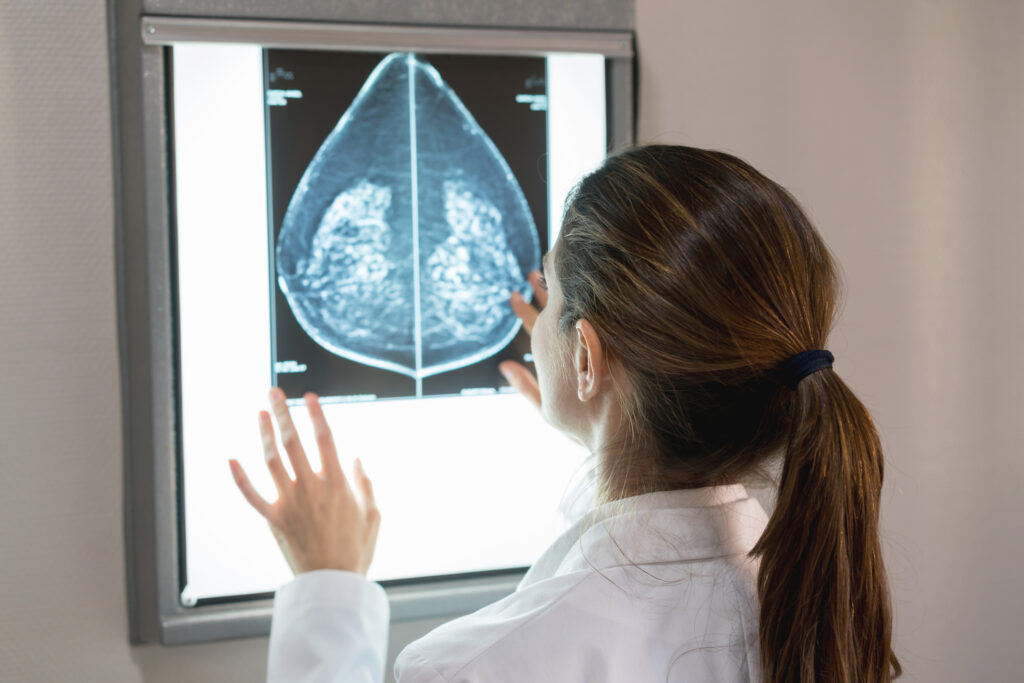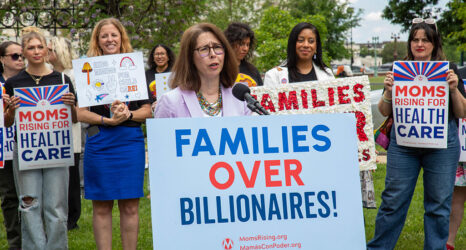The U.S. still lags in research on benign breast disease—like cysts, scar tissue and tumors—because it’s seen as “a woman’s disease.”

Paulette Kennedy did not expect her annual mammogram to come back inconclusive. The best-selling author previously had breast cysts and expected the follow-up ultrasound to show more of the same. Her worries increased when the ultrasound technician told Kennedy she needed a biopsy.
“This was the first time I actually had to wait a whole month between getting my ultrasound results and getting my biopsy,” Kennedy said. “During that month I had some of the worst anxiety of my life because my mom had just died from cancer.”
Eventually, Kennedy learned that the mass was a benign tumor called a fibroadenoma. It’s the most common breast tumor in premenopausal women and is estimated to impact one in four women overall. Despite its frequency, this was the first time she had ever heard the term.
Fibroadenomas are just one type of benign breast disease, a broad umbrella that includes things ranging from cysts and scar tissue to tumors. It’s different from having fibrocystic or “naturally lumpy” breasts, where lumpiness blends with normal tissue.
Depending on what type of benign breast disease (BBD) one has, it can also increase the risk of breast cancer. Conditions like atypical hyperplasia, where abnormal cells grow inside the ducts or lobules of the breast, can increase cancer risk by up to five times.
Some people may not notice anything wrong until they attend a regular breast screening. Others seek care the moment they notice a lump in their breast.
I fall into the second category.
I was officially diagnosed with my first fibroadenoma when I was 18, days after the World Health Organization declared COVID-19 a pandemic and life as I knew it ground to a halt. After three weeks of having stress dreams about taking breast cancer medication, the appointment finally came.
Like Kennedy, I had never heard of fibroadenomas—or any other kind of BBD. Yet, in the same year, an estimated 1.8 million people received care for non-malignant breast disease excluding tumors, according to the U.S. Medical Expenditure Panel Survey (MEPS).
In 2020, about 2 million people received care for primary malignant breast tumors. MEPS doesn’t have data on how many people were treated for benign breast tumors from 2016 to 2020, but according to the 2018 National Ambulatory Medical Care Survey, there were an estimated 178,868 office visits with a benign breast tumor diagnosis that year.
In the three years following my first treatment, I’ve learned a few things. Benign breast disease can respond to estrogen levels, similarly to breast cancer, but it can also be resistant to radiation and hormone therapy.
Family history is a risk factor. In fact, my mother was younger than I was when she found her first breast lump. Breast density is another. The FDA recently told mammogram providers to inform patients about breast density because it increases both the chances of breast cancer and of missing cancer on screenings.
I’ve also found that benign breast disease can come back. I developed another tumor two years after removing the first. On GoFundMe, I discovered a fundraiser for a woman who had a double mastectomy after her fibroadenomas kept coming back. She was only a few years older than I was. By this point, I no longer feared surgery or the possibility of having cancer; what concerned me was whether this could keep happening.
Benign breast disease can respond to estrogen levels, similarly to breast cancer, but it can also be resistant to radiation and hormone therapy.
Michele Coté, a molecular epidemiologist and director of the Susan G. Komen Tissue Bank at the IU Simon Comprehensive Cancer Center, does research on potential links between BBD and cancer. Although observational studies give a sense of who might be at increased risk, Coté told me that we still don’t know much about how BBD develops or how it’s inherited.
“Even scientists and researchers, unless they’re breast clinicians, surgeons or oncologists, don’t really have a grasp of what benign breast disease is,” Coté said. “It’s really understudied and underappreciated.”
Mayo Clinic and the University of Florida are currently doing epidemiologic studies similar to the work that Coté does. There have been ongoing studies on the genetic similarities between normal breast tissue and tumor tissue, and research on how cells divide in different tissue types. Benign tumors may be associated with a mutation in the MED12 gene, which regulates how genes are expressed and how cells divide. That mutation is also associated with uterine fibroids, a condition that the general public is starting to pay more attention to.
However, we still lack systematic research on recurrence, heredity and long-term risks of benign breast disease. Coté said securing research funding can be a challenge, which is part of a larger problem of funding women’s health issues.
One researcher found that conditions impacting women primarily do not get enough research funding, even though those conditions may be more prevalent in the U.S. population overall.
Headaches and migraines have a “high burden” in the population, meaning they’re very common, and disproportionately impact women. Still, headache research receives much less funding than expected for the number of people it impacts.
Another group estimates that the National Institutes of Health allocated about $2 per patient for endometriosis research in 2022. Endometriosis, an inflammatory condition of the uterus, is estimated to impact the same proportion of women as diabetes, which receives much more funding.
Last year, a resolution calling for investment in women’s health research was introduced in Congress, citing gendered disparities in research on Alzheimer’s disease, rheumatoid arthritis and coronary artery disease.
At times, it feels as though I am overstating the significance of BBD. After all, I am fortunate to not be living with breast cancer. However, even benign conditions can impact the quality of life.
For Kennedy, the combined stress of losing her mother and having “a potential life-altering diagnosis hovering over [her]” made it hard to concentrate on her work. Medical appointments, biopsies and surgeries can be costly. The years I had surgery were the years I spent the most out-of-pocket for healthcare, and in 2019, BBD patients spent $1,615 on average for care in the U.S.
There are also racial disparities with benign breast disease, just as there are with breast cancer.
“A lot of these benign tumors in the breast [and] fibroids in the uterus are much more common in Black women,” Coté said. “It’s something I think the medical community doesn’t take super seriously because it’s a woman’s disease, and fibroid tumors aren’t going to kill you, so oh well. But they don’t have respect or understanding for quality-of-life issues.”
Patient experiences are not a monolith, and we need more research on how these conditions develop and how we can address them. In addition to being beneficial for patients, more research will help avoid what clinicians call “overtreatment” and what health policy researchers call “low-value care,” which is health-care that has little benefit in the long run.
“I think we would be better off if more women knew that four out of five times this is just going to be benign, and there will be nothing further you need except for maybe an extra mammogram,” Coté said.
Raising awareness of BBD is important to me because of my own experience, as well as the implications that awareness has for public health. Knowing more about benign breast disease should start a larger conversation about women’s health, cancer risk factors and quality of life.
Analysis of the MEPS/NAMCS data relied on the following ICD-10 codes: D24 (benign neoplasm of the breast), C50 (malignant neoplasm of the breast), and N60-N65 (breast disorders).
Up next:
U.S. democracy is at a dangerous inflection point—from the demise of abortion rights, to a lack of pay equity and parental leave, to skyrocketing maternal mortality, and attacks on trans health. Left unchecked, these crises will lead to wider gaps in political participation and representation. For 50 years, Ms. has been forging feminist journalism—reporting, rebelling and truth-telling from the front-lines, championing the Equal Rights Amendment, and centering the stories of those most impacted. With all that’s at stake for equality, we are redoubling our commitment for the next 50 years. In turn, we need your help, Support Ms. today with a donation—any amount that is meaningful to you. For as little as $5 each month, you’ll receive the print magazine along with our e-newsletters, action alerts, and invitations to Ms. Studios events and podcasts. We are grateful for your loyalty and ferocity.





